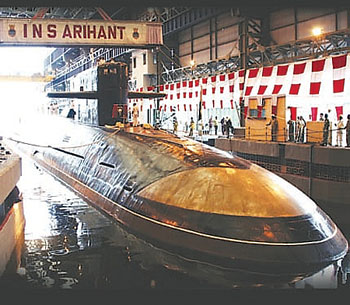INDIAN ARMED FORCES CHIEFS ON
OUR RELENTLESS AND FOCUSED PUBLISHING EFFORTS

SP Guide Publications puts forth a well compiled articulation of issues, pursuits and accomplishments of the Indian Army, over the years

I am confident that SP Guide Publications would continue to inform, inspire and influence.

My compliments to SP Guide Publications for informative and credible reportage on contemporary aerospace issues over the past six decades.
- Prime Minister witnesses 'Bharat Shakti' – a Tri-Services Firing and Manoeuvre Exercise in Pokhran, Rajasthan
- Interim Defence Budget 2024-25 — An Analysis
- Union Defence budget 2024
- Prime Minister Modi Commemorates Indian Navy Day in a Grand Ceremony
- Prime Minister Modi Flies in the LCA Tejas
- New Chapter in India-Italy Defence Ties
- Airpower beyond Boundaries
Arihant-functional arm of India’s nuclear triad

A decision to create indigenous design, development and construction capability for strategic arm of nuclear powered Ship Submersible Ballistic Nuclear (SSBN) was taken by the Government of India way back in the early 1970s. Under an umbrella of a classified project Advanced Technology Vehicle Project (ATVP) the programme was established. Since then ATVP has braved rough weathers and daunting challenges, over the past four decades, or more. The worst phase of the programme came with the downfall of former Soviet Union which under an Inter-Governmental Agreement had promised to help India in this indigenous endeavour.
With the launch of Arihant, which translates to annihilator of enemies, by the then Prime Minister Manmohan Singh on July 26, 2009, a major milestone in the success story of ATVP had been accomplished. Immediately thereafter most crucial phase for the first of indigenous nuclear-powered submarine began.

Arihant is propelled by an 83 MW pressurised light-water reactor at its core. In 2013, the nuclear reactor of Arihant went ‘critical’. Since then a series daunting trial began, the first being extensive Harbour Acceptance Trials (HATs). On successful completion of HATs from December 2014 onwards began the crucial Sea Acceptance Trials (SATs) which included extensive machinery, equipment and systems trials out at sea, on surface and submerged. The most intensive series of SATs was the test-firing of K-series of missiles. The K-series of missiles have been named after former President of India Dr A.P.J. Abdul Kalam. The K-15 submarine-launched ballistic missile has a range of 750 km and the K-4 has a range of 3,500 km. While the test-firings in surface and submerged modes have been entirely successful, the weapons integration is still work in progress. Based on the available reports, it can be safely assumed that it will not be long before Arihant is fully ready to be deployed for deterrent patrols with nuclear-tipped ballistic missiles in its silos. However, some sources believe that the vessel is “not yet fully ready” to be deployed for “deterrent patrols” with nuclear-tipped ballistic missiles in its four silos.
Practically all leading newspapers on October 17, 2016, announced that INS Arihant was formally commissioned by Admiral Sunil Lanba, Chief of the Naval Staff, in August 2016. At the same time same sources added that to maintain secrecy, it is not being referred to as INS Arihant. INS, which stands for ‘Indian Naval Ship’, is affixed to a ship only after it is inducted into service.
Capability of Arihant
Arihant, a 6,000-tonne nuclear-powered SSBN, is capable of carrying nuclear-tipped ballistic missiles and is designed to prowl the deep ocean waters, with unrestricted submerged endurance carrying nuclear weapons and provide India with an assured second strike capability — the capability to strike back after being hit by nuclear weapons first.
Arihant is equipped with better stealth features and is larger compared to SSNs, which are nuclear-powered attack submarines. SSBNs are also said to be the “best guarantor” of a second strike capability in a nuclear exchange. Arihant is equipped with shortrange missiles with a range of 700 km and also has ballistic missiles with a range of 3,500 km.
Completion of the nuclear triad is extremely critical for India given the country’s “No First Strike” policy. Second strike capability is particularly important for India as it had committed to a ‘No-First-Use’ policy as part of its nuclear doctrine.
Once Arihant is fully operational India will proudly claim the membership to the exclusive club of other ‘nuclear triad’ powers — UK, United States, China, Russia and France.
Dwindling Subsurface Fleet of Indian Navy
Even as Arihant is on the threshold of being inducted and the Indian Navy prepares to induct the Scorpene class INS Kalvari, there are major concerns over its ability to deter and counter the enemy with its dwindling subsurface force levels. The present submarine force level comprise of only 13 conventional and ageing submarines. In addition, INS Chakra is the only nuclear-powered submarine taken on lease from Russia. Last year, the government had approved the construction of six nuclear-powered submarines as part of the upgraded 30-year indigenous submarine construction and modernisation plan.
Conclusion
Commissioning of ships and submarines, especially those of strategic value, is done with great fanfare, pomp and show. This tradition is followed globally to prominently pronounce to the world, the growing prowess of maritime capability of a nation. Arihant having been launched on July 26, 2009, in keeping with the Indian Navy’s tradition will also be commissioned by none other than the Prime Minister of India as INS Arihant.





